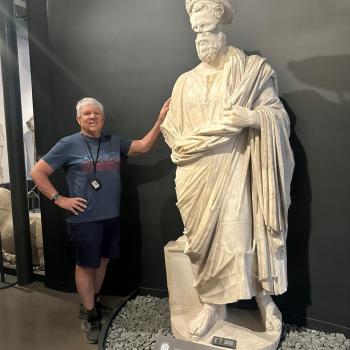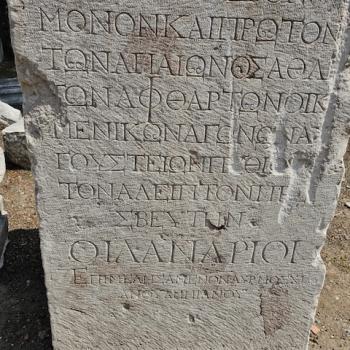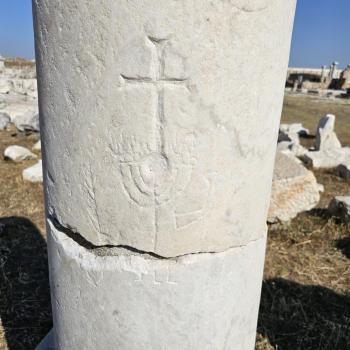 Dorothy Sayers (1893-1957) was one of the most important Christian writers of the twentieth century, and behind only Flannery O’Conner as a Christian woman writing fiction. At the peak of her career, she rivaled any of her Oxfordian Christian contemporaries called the Inklings (Lewis, Tolkien, Charles Williams, etc.). There must have been something in the water there in mid-century in Oxford as we have seldom seen such a large group of gifted Christian writers in one place at one period of time in the last five centuries.
Dorothy Sayers (1893-1957) was one of the most important Christian writers of the twentieth century, and behind only Flannery O’Conner as a Christian woman writing fiction. At the peak of her career, she rivaled any of her Oxfordian Christian contemporaries called the Inklings (Lewis, Tolkien, Charles Williams, etc.). There must have been something in the water there in mid-century in Oxford as we have seldom seen such a large group of gifted Christian writers in one place at one period of time in the last five centuries.
Sayers, an only child, was born on 13 June 1893 at the Head Master’s House Christ Church Cathedral, Oxford where her father, the Rev. Henry Sayers, M.A., was chaplain and headmaster of the Choir School.
In 1912, she won a scholarship to Sommerville College Oxford and studied modern languages and medieval literature. She finished with first-class honours in 1915. Although women could not be awarded degrees at that time, Sayers was among the first to receive a degree when the position changed a few years later, and in 1920 she graduated with an MA. Her personal experience of Oxford academic life may be glimpsed in her novel Gaudy Night.
Sayers was a good friend of C.S. Lewis and several of the other Inklings. On some occasions, Sayers joined Lewis at meetings of the Socratic Club. Lewis said he read The Man Born to be King every Easter (her famous radio play), but he claimed to be unable to appreciate detective stories. J. R. R. Tolkien read some of the Wimsey novels but scorned the later ones, such as Gaudy Night.
Sayers began working out the plot of her first novel some time in 1920–21. The seeds of the plot for Whose Body? can be seen in a letter Sayers wrote on 22 January 1921:
My detective story begins brightly, with a fat lady found dead in her bath with nothing on but her pince-nez. Now why did she wear pince-nez in her bath? If you can guess, you will be in a position to lay hands upon the murderer, but he’s a very cool and cunning fellow… (p. 101, Reynolds)
Lord Peter Wimsey burst upon the world of detective fiction with an explosive “Oh, damn!” and continued to engage readers in ten novels and two sets of short stories; the final novel ended with a very different “Oh, damn!”. Sayers once commented that Lord Peter was a mixture of Fred Astaire and Bertie Wooster, which is most evident in the first five novels. However, it is evident through Lord Peter’s development as a rounded character that he existed in Sayers’ mind as a living, breathing, fully human being. Sayers introduced detective novelist Harriet Vane in Strong Poison. Sayers remarked more than once that she had developed the “husky voiced, dark-eyed” Harriet to put an end to Lord Peter via matrimony. But in the course of writing Gaudy Night, Sayers imbued Lord Peter and Harriet with so much life that she was never able, as she put it, to “see Lord Peter exit the stage”.
Sayers did not content herself with writing pure detective stories; she explored the difficulties of World War I veterans in The Unpleasantness at the Bellona Club, discussed the ethics of advertising in Murder Must Advertise, and advocated women’s education (then a controversial subject) and role in society in Gaudy Night. In Gaudy Night, Miss Barton writes a book attacking the Nazi doctrine of Kinder, Kirche, Küche, which restricted women’s roles to family activities, and in many ways the whole of Gaudy Night can be read as an attack on Nazi social doctrine. The book has been described as “the first feminist mystery novel.”[10]
Sayers’ Christian and academic interests also shine through in her detective stories. In The Nine Tailors, one of her most well-known detective novels, the plot unfolds largely in and around an old church dating back to the Middle Ages, and the writer’s familiarity with and affection for such a milieu is very evident. Change ringing of bells also forms an important part of the novel. In Have His Carcase, the Playfair cipher and the principles of cryptanalysis are explained. Her short story Absolutely Elsewhere refers to the fact that (in the language of modern physics) the only perfect alibi for a crime trhis to be outside its light cone, while The Fascinating Problem of Uncle Meleager’s Will contains a literary crossword puzzle. (this summary courtesy of Wiki).
Sayers went on to write notable Christian works such as The Mind of the Maker, and Creed or Chaos, and a famous translation from the Italian of Dante’s Divine Comedy, the third part of which she never quite finished before she died. Having read almost everything she wrote, I can say that she is undeservedly the most neglected of the gifted Christian writers of the whole ‘Inkling period’. Here is the list of her novels and when they were written…..
- Whose Body? (1923)
- Clouds of Witness (1926)
- Unnatural Death (1927). From the papers held by the Marion E. Wade Center, it is clear that Sayers’ original title was The Singular Case of the Three Spinsters.
- The Unpleasantness at the Bellona Club (1928)
- Lord Peter Views the Body (1928) (12 short stories)
- Strong Poison (1930)
- Five Red Herrings (1931)
- Have His Carcase (1932)
- Hangman’s Holiday (1933) (12 short stories, 4 including Lord Peter)
- Murder Must Advertise (1933)
- The Nine Tailors (1934)
- Gaudy Night (1935)
- Busman’s Honeymoon (1937)
This post is focusing on the now available two sets of DVDs providing us with the BBC TV films of several, but sadly not all, of her novels. You will discover that all of the proper novels except the first and the last were in fact filmed in the two different BBC productions. More’s the pity in regard to the last especially when Wimsey and Vane actually tie the knot, so to speak.
The first BBC series of films were made in 1973-75. They star Ian Carmichael as Lord Peter and Glyn Houston as a warm and congenial Bunter, his war companion and later his man servant. These films are all feature length films, none shorter than 90 minutes and some longer, and it is a pity they have not been remastered, as they are very good. Especially the outdoor scenes suffer some from this earlier age of films, but both Set One and Set Two are excellent, full of repartee and good fun from the period of the 1920s and 1930s, and providing interesting social commentary on that turbulent period in England. If you liked ‘the King’s Speech’ you will like this mysteries as well, dealing with the same period in English life. Lord Peter is of course that most unusual of detectives— an aristocratic one, with a monocle no less. I especially loved both the novel The Nine Tailors, and the film of it.
The Second BBC series was filmed in 1987ff. and involves just three novels, the ones with Harriet Vane in them– Strong Poison, Have his Carcase, and Gaudy Night. Harriet, whom Wimsey falls in love with, and basically rescues from the hangman’s noose, is a modern woman, and of course there was much speculation about her reflecting Sayer’s own character, who was indeed a very progressive woman for her day. In this series of films Edward Petherbridge plays Lord Peter, with a bit less jolly and more reserved and foppish approach to the character, and on the whole I must say I prefer Carmichael, though Petherbridge looks the part, and is good in dialogue especially. Bunter in these films is less in evidence, in part because the second main character is Harriet Vane, played by Harriet Walter who is quite good as a conflicted and bright woman who is a novelist. The cinematography is much better in these films, to say the least and they also ably portray the period of the 1930s. If only they could have filmed Busman’s Honeymoon, but apparently the keepers of Sayer’s estate wouldn’t allow it. Odd.
In any case, if you are looking for some excellent entertainment with sparkling dialogue and wit, which also educates in various ways, you will find that these DVDs will keep you occupied for quite a few weeks of enjoyable viewing, watched one episode at a time. My wife and I worked through them between just after Christmas and now, and a good time was had by the both of us.












